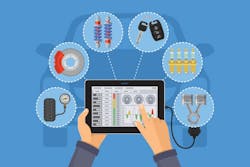Having an in-depth diagnostic process was something in which Olympia, Wash.-based Terry’s Automotive always found pride. However, the shop and its technicians tended to shy away from European vehicles, believing the diagnostic process would be too challenging for its managers and technicians to learn.
Roughly six years ago, more and more European vehicles started showing up in the neighborhood, and it no longer made financial sense for the shop to continue turning these vehicles away. However, that meant the staff, including performance shop manager Will Honemann and owner Robert Holmstrom, had to go through a major learning curve. The staff had to learn the diagnostic side of these European vehicles to figure out how to service the vehicles while making sure the shop continued to run efficiently.
After working through a learning curve of getting acquainted with the new software, Honemann is now at the point where he can confidently tell customers that he should be able to do a full diagnostic process on the cars within an hour. Additionally, Holmstrom says the shop’s foray into European vehicle has increased revenue in the diagnostic and driveability end of the business by roughly $125,000–$150,000 annually.
“It’s always a learning curve, with new cars, new techs,” Honemann says. “But once you have that learning curve down, it allows you to bring in more things, and really win long term.”
It all happened by training a staff that could effectively diagnose these cars, charge correctly, and communicate the importance to the customer and why charging for diagnostics is necessary.
The Backstory
Robert’s father, Terry, started Terry’s Automotive in 1980 with one 7,500-square-foot main building. Ten to 12 years later, he opened another building, grew the business, and focused on alignments, and front-end parts.
Five to six years after that, the shop grew even more, and opened up its performance building, which Honemann now runs. The 4,000-square-foot building has four techs, and focuses mainly on driveability and diagnostic work.
The staff tells customers the shop will start with an hour for diagnosis, at a labor rate of $112.75, and from there, they sell more time depending on the problem. Up until this year, the shop charged $102.95 per hour, but increased the cost to catch up with the ongoing cost of doing business, and account for technican’s time.
“We start there, and make sure the customer knows it’s going to be up to an hour’s charge for diagnosis,” Holmstrom says. “We won’t go over that without talking to them.”
For any customers who dispute the charge, Honemann says there are other shops in town to which they can take their car.
“Sometimes you have to stay away from the headache,” Honemann says. “If I have somebody who’s that cheap, I don’t want them here anyway.”
The Problem
Roughly five years ago, the European market around Terry’s Automotive started growing exponentially, and Honemann saw the surrounding customer base transition more from a domestic market to European market.
In sending European cars away, Honemann and Holmstrom knew the shop was missing out on a major moneymaker, so they decided to pivot and make an investment on servicing any vehicle that came through the shop. When the local Volvo dealership closed down, the shop faced an even bigger influx of cars, and Holmstrom knew the shop had to pivot.
“That’s when we really started getting into computer programming, reflashing, Volvo software and kind of grew from there,” Holmstrom says. “From there, we did more BMW, Mercedes software, things like that.”
Implementing this new service put a damper on productivity, as the techs had to learn the process, with which they were unfamiliar.
Not only did the European cars require a different scan tool software package, but the technicians also had to work around the new software, and learn how to diagnose the cars. They had to work through some bumps in the road, productivity wise, and make a long-term investment.
The Solution
The shop’s investment in the equipment to service these vehicles was the easier part, according to Holmstrom. Each technician owns his or her own scan tool, with brands from Snap-on, Autel, and Matco, which ranged from $2,000–$4,000. Additionally the business bought equipment to do computer flashing and reprogramming, like a new laptop, and battery charger, roughly costing $3,000.
The bigger investment was on the staff’s time.
Honemann and his staff found that some scan tool brands were easier to adapt to than others, and some repair information databases varied in quality, as well.
To get past this, here are Honemann and Holmstrom’s four keys to making this work:
Keep techs motivated:
Initially, Honemann saw some resistance from his techs, but he pushed through and stressed how much of a moneymaker it would be for the shop, and the technicians. He kept scheduling the repairs, and convinced his service manager to take on more and more of the vehicles.
Honemann has productivity bonuses where he wants to see each technician reach $20,000 in sales per month. The techs are paid hourly, but if they reach the $20,000 benchmark, they reach a bonus.
“When they’re doing well, they get paid well, too,” Honemann says. “There’s times where a guy might get a $1,000 bonus for the month.”
Invest in training:
Training was a major part of this transition, as well. The shop sent one technician who solely went to training on how to handle these diagnostic systems, so he could be the go-to guy.
Apart from the one tech who was trained in diagnostic processes, the shop sent many techs out to ACDelco and NAPA training.
Sell it to customers:
Communicating with customers is key for all diagnostic issues, but especially when working through a new diagnostic process. While the shop almost never goes past its typical one-hour diagnosing process, there are times when the technicians might see something unusual, and have to take more time to pinpoint a problem.
“You have to tell customers what’s going on,” Honemann says. “Just say that we’re looking at it, we’re trying to help; usually they respect that. It’s a balance; you have to make money, have to be able to take care of your other customers.”
Occasionally the shop had to bite the bullet and cut the charges, like charging one hour of diagnosis time on a car that took three hours, but Honemann says that was very rare. With the training that it takes, Honemann and Holmstrom say it’s important to charge for their technicians’ time, and they make sure to communicate that with each customer.
Don’t overlook the simple things:
Even when going about this diagnostic process, Honemann says you can’t overlook the finer details that may even cut down or eliminate the need for your shop to do a full diagnostic check.
It’s important for the service writers to get as much information from your customers as you can up front, with an in-depth work order. From there, a technician should do a visual inspection, walking around the vehicle and seeing if anything looks out of place.
“Half the time you get so involved with technicality of stuff, you miss things right in front of your face,” Honemann says. “You have to ask yourself: Does it smell funny? Does it sound funny?”
The Aftermath
Over the last several years, after settling in to servicing European vehicles, Holmstrom estimates the shop jumped its average ticket by roughly $150.
“Once you get past that initial learning curve, you realize there’s plenty of money here. We were pushing away a lot of things,” Honemann says. “Sometimes you take a bit of a loss to get that education to really win long term.”
In going through this process, the shop has developed a new-found confidence on diagnosing all vehicles.
“In the last 12 years, only a handful of cars that left here that did not get fixed, did not get repaired, didn’t have a solid answer on what was wrong with it,” Honemann says. “If we can’t fix it, it’s done.”
The Takeaway
Honemann says his shop’s newfound focus on European vehicles and its diagnostic process has paid off dividends for his shop’s bottom line and technicians, but most of all, for its customer base.
“Ultimately I want to be able to do as much as we can for the customer. When you can do something that nobody else can, you have that customer for everything else,” Honemann says. “If you fix a problem that four other shops couldn’t take care of, chances are they’re going to bring it to you for the oil changes, and the gravy money-making jobs, as well. Then they’re probably going to tell a dozen people.”
SHOP STATS: Terry's Automotive Location: Olympia, Wash. Operator: Robert and Tod Holmstrom Size: 17,000 square feet (combined all three buildings) Average Monthly Car Count: 779 Staff Size: 25 Annual Revenue: $3.5 million

